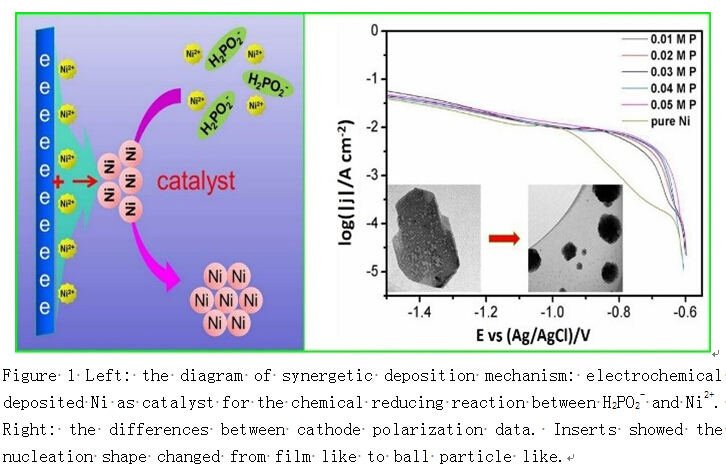Electrochemical deposition and chemical deposition, as two kinds of commonly used liquid deposition methods, can fabricate many kinds of metallic films such as Ni, Cu, Zn and Cr films for their high brightness, magnetic property, excellent anticorrosion property. And these two methods are widely used in our daily lives and scientific research. And also some kinds of functional films like special wetting ability films have been prepared by liquid deposition.
Prof. Xuedong Wu’s group at CNITECH has fabricated patterned tailored films with different hydrophobicity and the results were published on Chem. Comm (2013,49, 2424-2426)and ACS Appl. Mater. Interfaces (2014, 6 (2), 1053–1060). Recently, this group illustrated the nucleation mechanism of Ni-P deposit that was prepared by synergetic effect of electrochemical deposition and chemical deposition. The mechanism was studied by electrochemical analysis method. The cathode polarization and chronoamperometry method were performed to explore the effect of the reducing reaction (chemical deposition) on Ni electrochemical deposition. It was found that the addition of reducing agent in this solution induced the depolarization phenomena and decreased or vanished the double electric layer capacitance. The chronoamperometry experimental data was analyzed and fitted according to the Scharifker-Hills rule to discover the mechanism difference between Ni nucleation and Ni-P nucleation. The morphology of Ni-P and pure Ni deposits was measured by TEM and SEM demonstrating the ball like particle shape Ni-P and flat pure Ni deposits. The nucleation mechanism was proposed that the active Ni atoms was produced by electrochemical deposition acted as catalyst for reduction of reducing agent NaH2PO2 with nickel ions at cathode surface. The occurrence of reducing reaction of NaH2PO2 with nickel ions hindered the in-plane growth of nickel crystal particles generating the ball particle shape deposit.
This work is devoted to reveal the nature of the particles morphology produced by the synergetic of electrochemical deposition and chemical deposition, which can promote the future work on functional film preparation and insight on how to grow nano particle materials. And the result is published on the journal of RSC advances (2015,5, 27242-27248).

Prof. Xuedong Wu : xdwu@nimte.ac.cn
Research Staff Url: http://english.nimte.cas.cn/pe/fas/200909/t20090929_44484.html
All Images by ![]()

